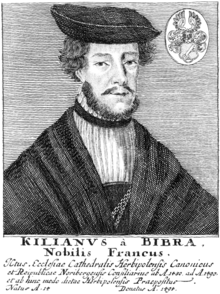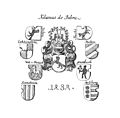Kilian of Bibra

Kilian von Bibra (* around 1425; † February 13, 1494 ) was a doctor of canon law and obtained high ecclesiastical offices, u. a. he was provost and vicar general in Würzburg .
Kilian in the context of the Bibra family
The von Bibra family is an old Thuringian - Franconian noble family. Kilian probably also grew up at the headquarters in Bibra in the southern district of Schmalkalden-Meiningen in Thuringia .
The von Bibra held numerous ecclesiastical offices in the Middle Ages. You were several times Würzburg prince-bishops and canons in Bamberg and Würzburg . As Vicar General of the Diocese of Würzburg , Kilian was deputy to Archbishop Rudolf II von Scherenberg . He was to follow as Archbishop Lorenz von Bibra . Together with Kilian and Albrecht von Bibra they rebuilt the church of St. Leo in Bibra and put their coats of arms in the church windows.
History of Kilian
Kilian studied from 1441 to 1444 in Erfurt , from 1449 in Padua in Italy and graduated in 1450 as a doctor of canon law ( doctoratus in iure canonico ). In 1443 he is recorded as domicellar and in 1456 as canon, in 1464 he received a canonical in the Haug monastery . In 1476 he was provost of Neumünster Abbey and was involved in the persecution and questioning of the preacher Hans Böhm . Kilian rose to the Dompropst in 1483 and Vicar General in 1486 in Würzburg . He also held other ecclesiastical offices and in this context also owned considerable land. He was entrusted with diplomatic trips and was also considered an advisor to Emperor Maximilian I.
Kilian was a member of the German brotherhood at Santa Maria dell'Anima in Rome.
In connection with the Niklashauser pilgrimage in 1476, he sent fellow believers to Niklashausen to convict Hans Böhm as a charlatan , but this did not succeed. The events around Hans Böhm are interpreted as harbingers of the Bundschuh movement and the peasant war .
Burial place
His tombstone is in the Würzburg Cathedral of St. Kilian . It is a metal plate in the Kapitelhaus in Würzburg. A round bronze attachment has disappeared. It contained briefly in Latin script the titles obtained and the year of death of Kilian. The central motif was a skull as a symbol of transience.
Coat of arms after Johann Octavian Salver 1775
literature
- Wilhelm Freiherr von Bibra: Contributions to the family history of the imperial barons of Bibra. (BD. 1) 1880, pp. 50-68.
- Friedrich Merzbacher : Kilian of Bibra . In: Franconian pictures of life. Vol. 5 (1973). Pp. 97-134.
- Johann Octavian Salver: Samples of the high Teütschen Empire nobility or collections of old monuments, gravestones, coats of arms, inscriptions and original inscriptions, ud Taken from their true archetypes, tried and tested with open faithfulness, and other news explained and explained through ancestral trees (Würzburg, 1775)
- Werner Schultheiß: Bibra, barons of . In: New German Biography. Vol. 2. Berlin 1955. pp. 215/216.
- Werner Wagenhöfer: The Bibra: Studies and materials on genealogy and ownership history of a Franconian lower nobility family in the late Middle Ages. Verlag Degener & Co, 1998; ISBN 3-7686-9147-0 .
- Sebastian Zeißner: Dr. Kilian of Bibra. Provost of Würzburg . In: Mainfränkisches Jahrbuch für Geschichte und Kunst 2 (1950).
- Carl Ruland: Bibra, Kilian von . In: Allgemeine Deutsche Biographie (ADB). Volume 2, Duncker & Humblot, Leipzig 1875, p. 613.
Web links
- Biography about Kilian von Bibra in the Rhönlexikon
- Kilian at vonbibra.net (in English)
- Chancellery and form book of Kylian von Bibra (manuscript M.ch.f.58 of the University Library of Würzburg )
| personal data | |
|---|---|
| SURNAME | Bibra, Kilian of |
| BRIEF DESCRIPTION | Provost and Vicar General in Würzburg |
| DATE OF BIRTH | around 1425 |
| DATE OF DEATH | 1494 |





